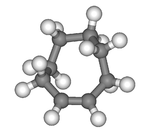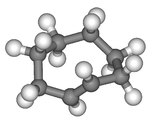trans-Cyclooctene
trans-Cyclooctene is an organic compound with the formula (CH2)6(CH)2. It is a colorless liquid. Cyclooctene is notable as the smallest cycloalkene that is readily isolated as its trans-isomer. The cis-isomer is much more stable.[2]
 |  |
| cis-Cyclooctene | trans-Cyclooctene |
 | |
| Names | |
|---|---|
| IUPAC name
(E)-Cyclooctene | |
| Other names
trans-Cyclooctene | |
| Identifiers | |
3D model (JSmol) |
|
| ChEBI | |
| ChemSpider | |
| EC Number |
|
PubChem CID |
|
| |
| |
| Properties | |
| C8H14 | |
| Molar mass | 110.200 g·mol−1 |
| Appearance | colorless liquid |
| Density | 0.848 g/mL |
| Melting point | −59 °C (−74 °F; 214 K) |
| Boiling point | 143 °C (289 °F; 416 K) |
| Hazards | |
| GHS pictograms |   |
| GHS Signal word | Danger |
Except where otherwise noted, data are given for materials in their standard state (at 25 °C [77 °F], 100 kPa). | |
| Infobox references | |
The molecule is shaped like the 8-carbon equivalent chair conformation of cyclohexane. It is chiral (the two enantiomers are shown in the table above). This type of chirality is defined as planar chirality.[3] It has been resolved into optical isomers.[4]
Preparation
trans-Cyclooctene was first synthesized on a preparatory scale by Arthur C. Cope with a Hofmann elimination reaction of N,N,N-trimethylcyclooctylammonium iodide.[5] The reaction gives a mixture of cis and trans isomers, and the trans isomer is selectively trapped as a complex with silver nitrate. Other methods exist where the trans-isomer is synthesized from the cis-isomer in several synthetic steps. In addition, a photochemical method exists for the direct cis–trans isomerisation.
Although this equilibrium strongly favours the more stable cis form, the reaction can be driven towards the trans by trapping with silver ions.[6]
References
- "cis-Cyclooctene". Sigma-Aldrich.
- Neuenschwander, Ulrich; Hermans, Ive (2011). "The Conformations of Cyclooctene: Consequences for Epoxidation Chemistry". J. Org. Chem. 76 (24): 10236–10240. doi:10.1021/jo202176j.
- IUPAC, Compendium of Chemical Terminology, 2nd ed. (the "Gold Book") (1997). Online corrected version: (2006–) "Planar chirality". doi:10.1351/goldbook.P04681
- Steven D. Paget (2001). "(−)-Dichloro(ethylene)(α-methylbenzylamine)platinum(II)". Encyclopedia of Reagents for Organic Synthesis. John Wiley & Sons. doi:10.1002/047084289X.rd119.CS1 maint: uses authors parameter (link)
- Cope, Arthur C.; Bach, Robert D. (1969). "trans-Cyclooctene". Organic Syntheses. 49: 39.; Collective Volume, 5, p. 315
- Royzen, Maksim; Yap, Glenn P. A.; Fox, Joseph M. (2008). "A Photochemical Synthesis of Functionalized trans-Cyclooctenes Driven by Metal Complexation". J. Am. Chem. Soc. 130 (12): 3760–3761. doi:10.1021/ja8001919.